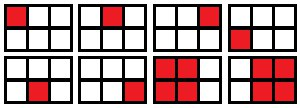Spongebob is already tired trying to reason his weird actions and calculations, so he simply asked you to find all pairs of n and m, such that there are exactly x distinct squares in the table consisting of n rows and m columns. For example, in a 3 × 5 table there are 15 squares with side one, 8 squares with side two and 3 squares with side three. The total number of distinct squares in a 3 × 5 table is 15 + 8 + 3 = 26.
The first line of the input contains a single integer x (1 ≤ x ≤ 1018) — the number of squares inside the tables Spongebob is interested in.
First print a single integer k — the number of tables with exactly x distinct squares inside.
Then print k pairs of integers describing the tables. Print the pairs in the order of increasing n, and in case of equality — in the order of increasing m.
26
6 1 26 2 9 3 5 5 3 9 2 26 1
2
2 1 2 2 1
8
4 1 8 2 3 3 2 8 1
In a 1 × 2 table there are 2 1 × 1 squares. So, 2 distinct squares in total.

In a 2 × 3 table there are 6 1 × 1 squares and 2 2 × 2 squares. That is equal to 8 squares in total.

分析:手动推导一下a*b的矩阵中正方形个数的公式然后暴力枚举即可。
#include <cstdio>
#include <iostream>
using namespace std;
struct thing
{
long long x,y;
} ans[1000000];
long long a,n,tot,same;
int main()
{
cin.sync_with_stdio(false);
cin>>n;
long long i = 1;
while(true)
{
long long b = (i-1)*i*(2*i-1)/6 - i*i*(i-1)/2;
if(b >= n) break;
long long k = i*(i+1)/2;
if((n - b) / k < i) break;
if((n - b) % k == 0)
{
ans[++tot].x = i;
ans[tot].y = (n - b) / k;
if(ans[tot].x == ans[tot].y) same++;
}
i++;
}
cout<<2*tot-same<<endl;
for(int i = 1;i <= tot;i++) cout<<ans[i].x<<" "<<ans[i].y<<endl;
for(int i = tot;i;i--)
if(ans[i].x != ans[i].y)
cout<<ans[i].y<<" "<<ans[i].x<<endl;
} 







 海绵宝宝面临一个数学挑战:找出所有可能的n和m值,使得n行m列的表格中恰好包含x个不同的正方形。本文提供了一个编程解决方案,通过手动推导公式并进行暴力枚举来解决这个问题。
海绵宝宝面临一个数学挑战:找出所有可能的n和m值,使得n行m列的表格中恰好包含x个不同的正方形。本文提供了一个编程解决方案,通过手动推导公式并进行暴力枚举来解决这个问题。
















 1216
1216

 被折叠的 条评论
为什么被折叠?
被折叠的 条评论
为什么被折叠?








